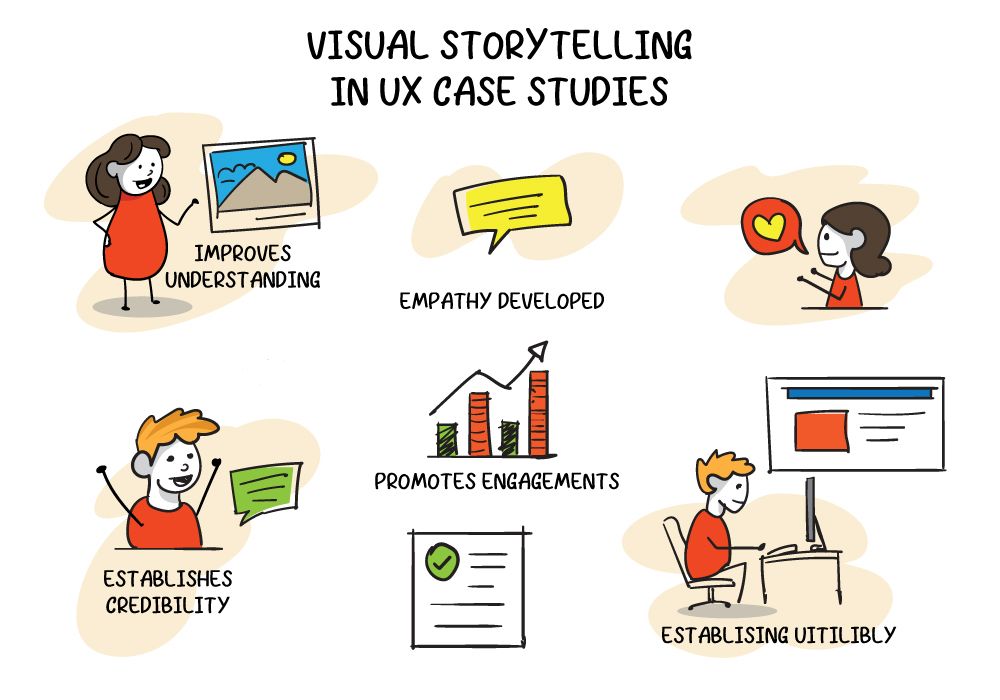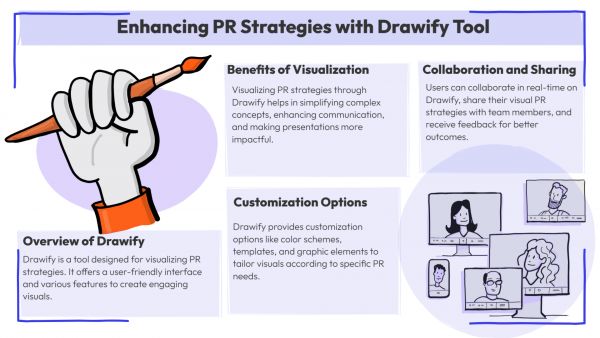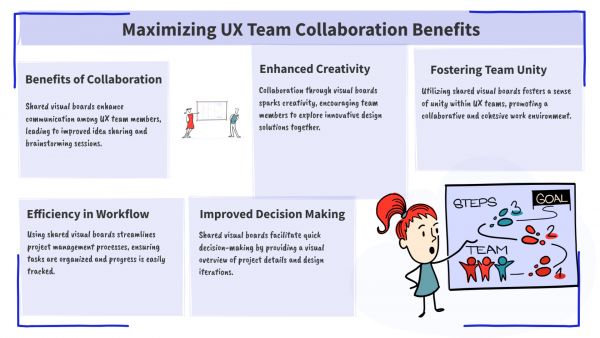Whether you've got stories to tell or art to create, there's a place for you here.

UX Designers
Visual Storytelling Techniques for UX Case Studies

-
ARAnshu Raj- Founder & CEO, Drawify
-
Aug 15, 2025 5 min read
Storytelling is far more than an eye-catching buzzword in the field of user experience (UX) design; it's an essential tool for clearly expressing your design approach, problems, and solutions. By adding captivating images to support the narrative, visual storytelling advances one step further, making challenging UX case studies easier to understand, remember, and relate to. Visual storytelling approaches can help bring cases to the next level, whether diving an experienced UX expert presenting a work to stakeholders or a young designer developing a portfolio of work.
In this article, we're going to look through key visual storytelling techniques that can help you turn your UX case studies into powerful, audience-resonant stories.
The Significance of Visual Storytelling in UX Case Studies:
Traditional case studies with an extensive amount of text often fail to captivate readers' attention. By integrating storytelling with visuals, visual storytelling bridges this gap and allows readers to enjoy the journey along the way. These are the reasons why it matters:
- Improves Understanding: Images make difficult facts and decisions concerning design clearer to understand.
- Promotes Engagement: Visual content is more likely to remain in readers' minds.
- Empathy is Developed: Story-driven graphics give the design process a human face.
- Establishes Credibility: A well-written, well-organised account shows consideration and professionalism.
Key Elements of UX Visual Storytelling:
Using visual storytelling in UX case studies requires integrating crucial storyline details with well-considered visual elements.
- Establish a Setting with Background:
In order to understand the above-mentioned aspects, the use of graphics will help, such as:
- Screenshots of products and client logos
- Personas of users with visually appealing avatars
- Maps of empathy or journey maps
The above elements contribute to making it easier for the audience to understand the story's who, what, and why right away.
- Demonstrate the Design Process in Terms of Appearance:
The user is expected to avoid using lengthy paragraphs to describe the process in detail. Instead, constitute the implementation of a process diagram or timeline graphic that shows the following stages:
- Investigate
- Concept
- Wireframing
- Making Prototypes
- Examining
- Iteration
Add real artefacts such as:
- Low-fidelity wireframes or sketches
- Interactive Mockups
- Highlights of usability testing (screenshots or quick videos)
This process sounds authentic, open, and simple to follow as a consequence of the above images.
- Make Strategic Use of Data Visualisations:
Use the following in place of tables or text blocks for presenting research findings or test results:
- Bar Charts (such as those showing task completion rates)
- Pie Charts (such as those displaying survey results)
- Heatmaps (such as those showing patterns of user activity)
Well-crafted data visualisations give the arguments quick support and give your choices considerable legitimacy.
- Introduce Real User Stories and Quotations:
It requires significance to have emotional resonance. Incorporate authentic user quotes into stylised blocks or with visuals that strengthen the findings and demonstrate their influence. Application: the act of-
- Speech Bubbles with Illustrations
- Pull Quotes with Bold Font
- User Persona-representing Icons
This boosts authenticity and promotes design that is driven by empathy.
- Highlight Significant Design Choices and Trade-offs:
Instead of stating, "We changed the navigation layout," it is expected to emphasise on the improvements with before-and-after screenshots. The following annotations can be used:
- Callouts and Arrows
- The Notes with Colour Coding
- Short captions that explain decisions
Using the above technique, one can see how one might tackle challenges.
- Use Interactive Elements and Motion as Often as You Can:
Incorporate the animation technique transitions, dwell states, or micro interactions that resemble the behaviour of the final product when the case study has been placed online. These components can be implemented with the use of tools like Webflow, Adobe XD, or Figma.
As a result, users may do more than merely read about the layout of the design.
- Conclude with Thought and Impact:
Avoid concluding with "Project complete." Rather, end with:
- Impact Indicators (such as "A 40% increase in task success")
- Knowledge Acquired
- Prospects for the Future
Put these factors into a Visual form using:
- A Dashboard of Success Metrics
- A "retrospective" board in pictorial form
- An illustration of a roadmap
This highlights long-term value and demonstrates that the design approach is mature.
Tools to Enhance UX Case Studies' Visual Storytelling:
Generating visually appealing case studies can be streamlined with the correct tools, such as:
- Drawify: Perfect for flow diagrams, visual metaphors, and creative graphics.
- Figma: For collaborative storytelling and interactive design prototypes.
- Canva: For creating neat, well-executed visual materials fast.
- Miro: Ideal for creating sitemaps, brainstorming graphics, and charting user journeys.
- Notion/Medium/Read.cv: Fantastic platforms for publishing media-rich, properly formatted UX Case Studies.
SEO-Friendly Suggestions for Publishing Your UX Case Study:
While sharing your case study online, especially on your portfolio site or blog, it is advised to keep these SEO tips in mind:
- Use Target Keywords like “UX case study,” “user experience design process,” “UX storytelling,” etc.
- Structure your Content with H1, H2, and H3 Headings.
- Optimise Image alt text (e.g., “UX process timeline,” “wireframe example”).
- Add Meta Titles and Descriptions focused on your niche (e.g., "UX Case Study: Visual Storytelling Techniques for Product Redesign").
- Include Internal links to other portfolio pieces or blog posts.
To conclude, it is important to enhance your UX Case Studies with Visual Storytelling. Visual storytelling has evolved from a modern artistic approach to a strategic need for UX designers in today's competitive online world. Writing engaging UX case studies nowadays involves more than just offering fixes; it also includes creating a compelling story. Visuals, plot elements, design artefacts, and data can all be easily integrated to create memorable and immersive experiences that demonstrate your design thinking and problem-solving techniques.
Whether you're presenting your work to recruiting managers, pitching to clients, or developing your UX portfolio, these visual storytelling approaches can drastically enhance your presentation. They enable you to stand out in a crowded field, emotionally connect with your audience, and convey complicated ideas.
- Events
- Workshops
- Visual Storytelling
- How to video
- Communities
- Sketchnoting
- Templates
- UX Designers
- Agile Professionals
- Product Managers
- Freelance Graphic Designers
- Creative Tech Enthusiasts
- Online Course Creators
- Social Media Content Creator
- Creative Agency Owners
- Marketing Professionals
- EdTech Professionals
- Scrum Masters
Come, Be Part of Something Special
-
Got ideas that need visual superpowers?
Jump in and start creating presentations and communications that people actually remember.
Sign In -
Are you an artist ready to grow?
Join our Drawifier family and focus on what you love most - creating art that matters.
Become a Drawifier
Get visualisation tips every week
Subscribe to the Drawify Newsletter, and feed your creativity with visualisation tips and techniques, as well as the latest Drawify workshops, news and resources.




